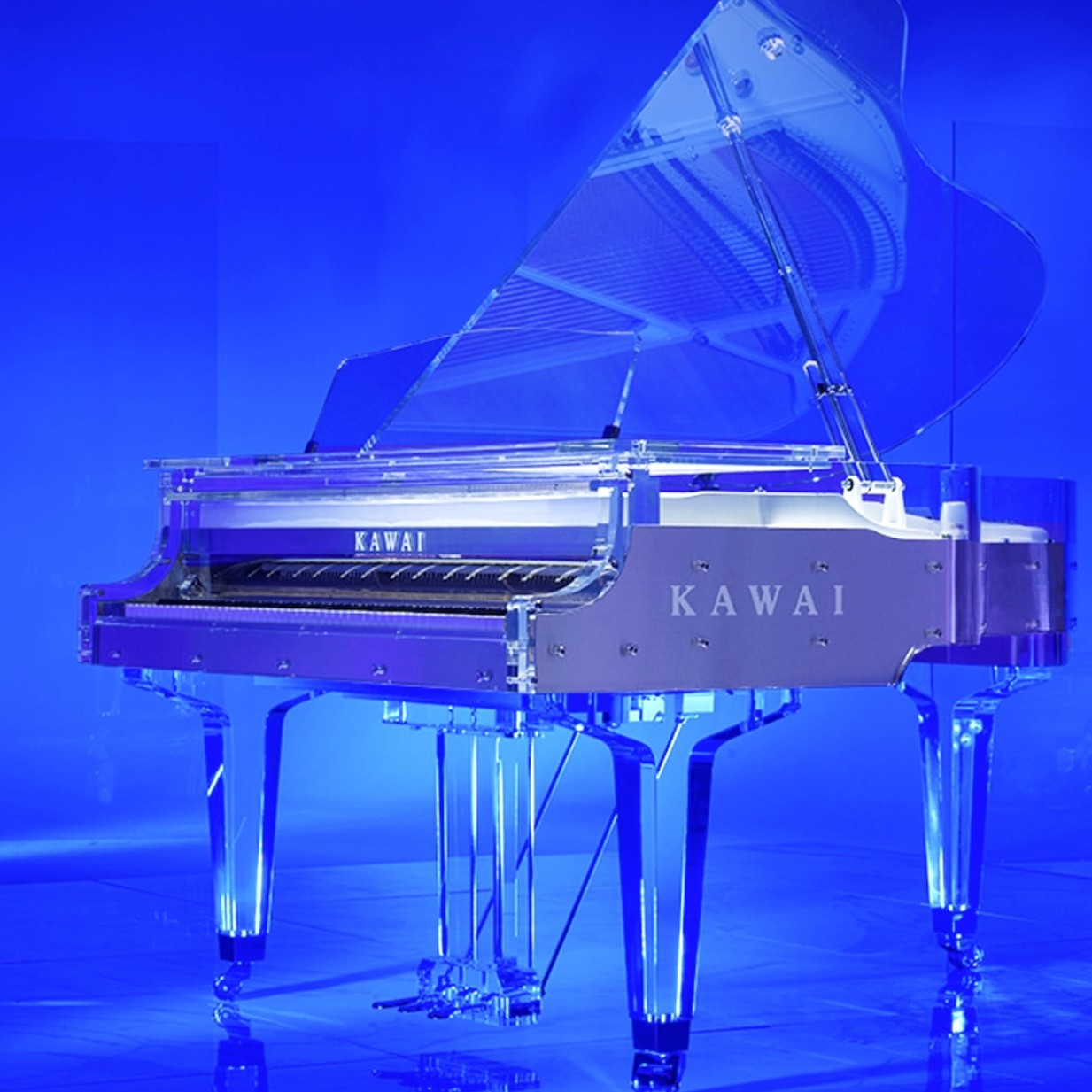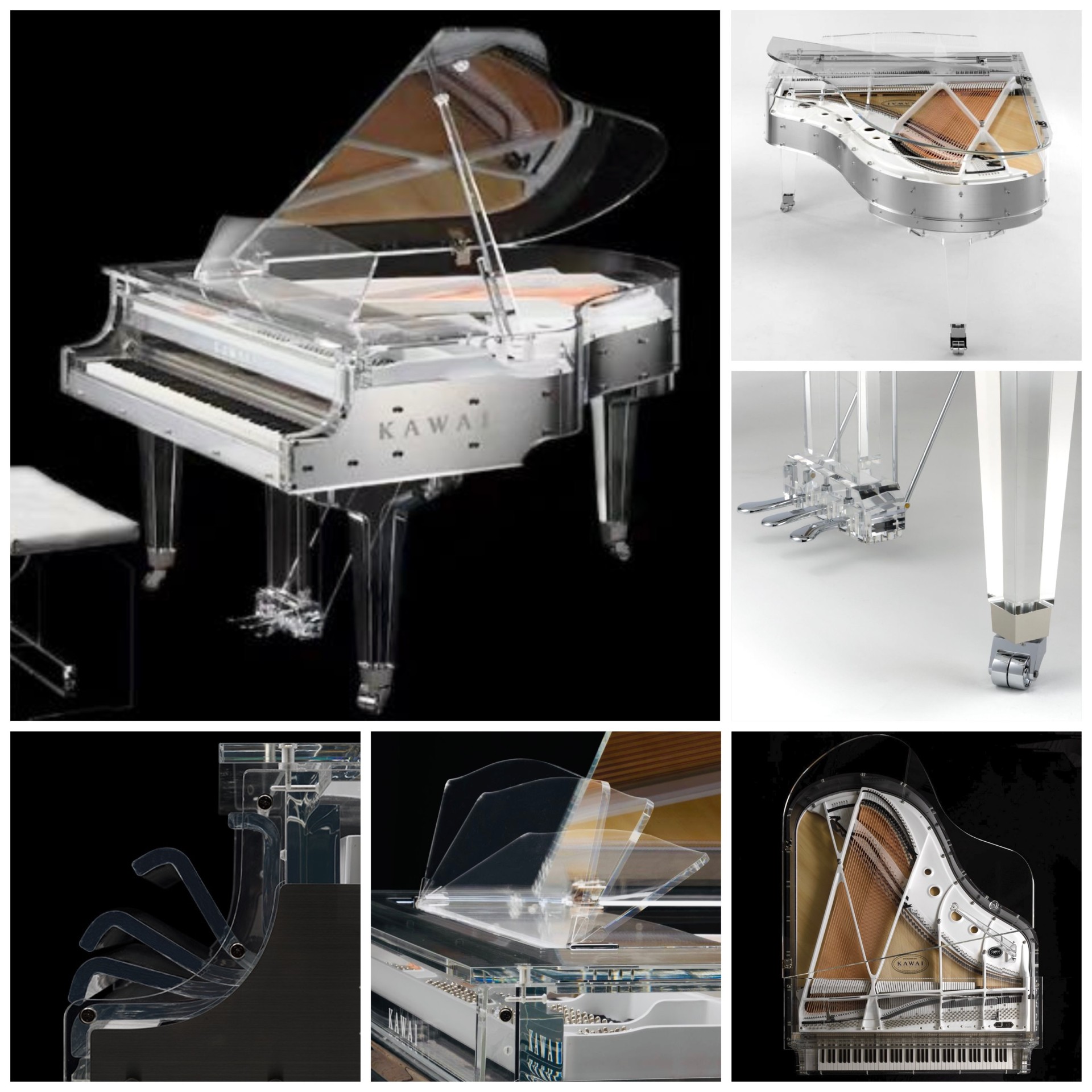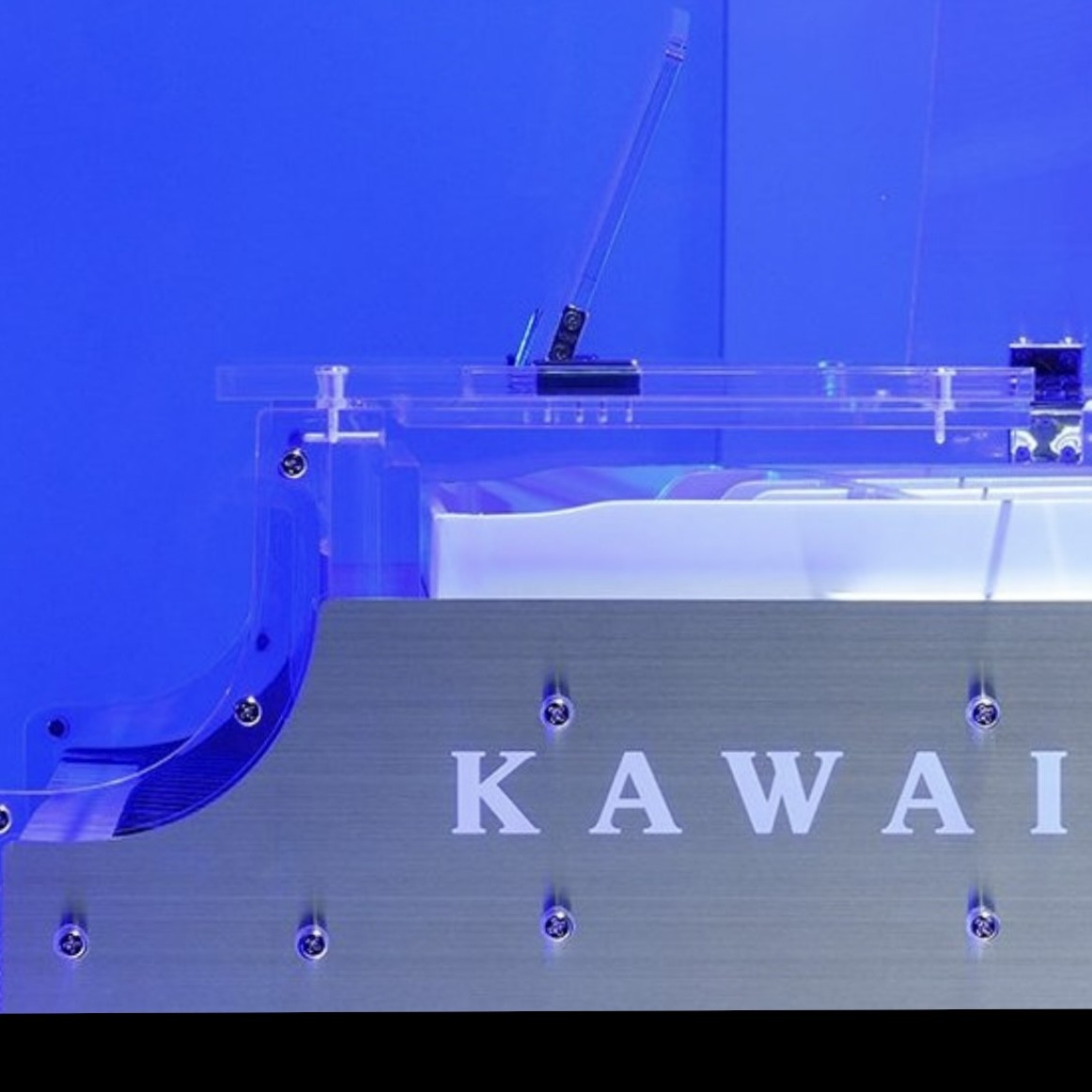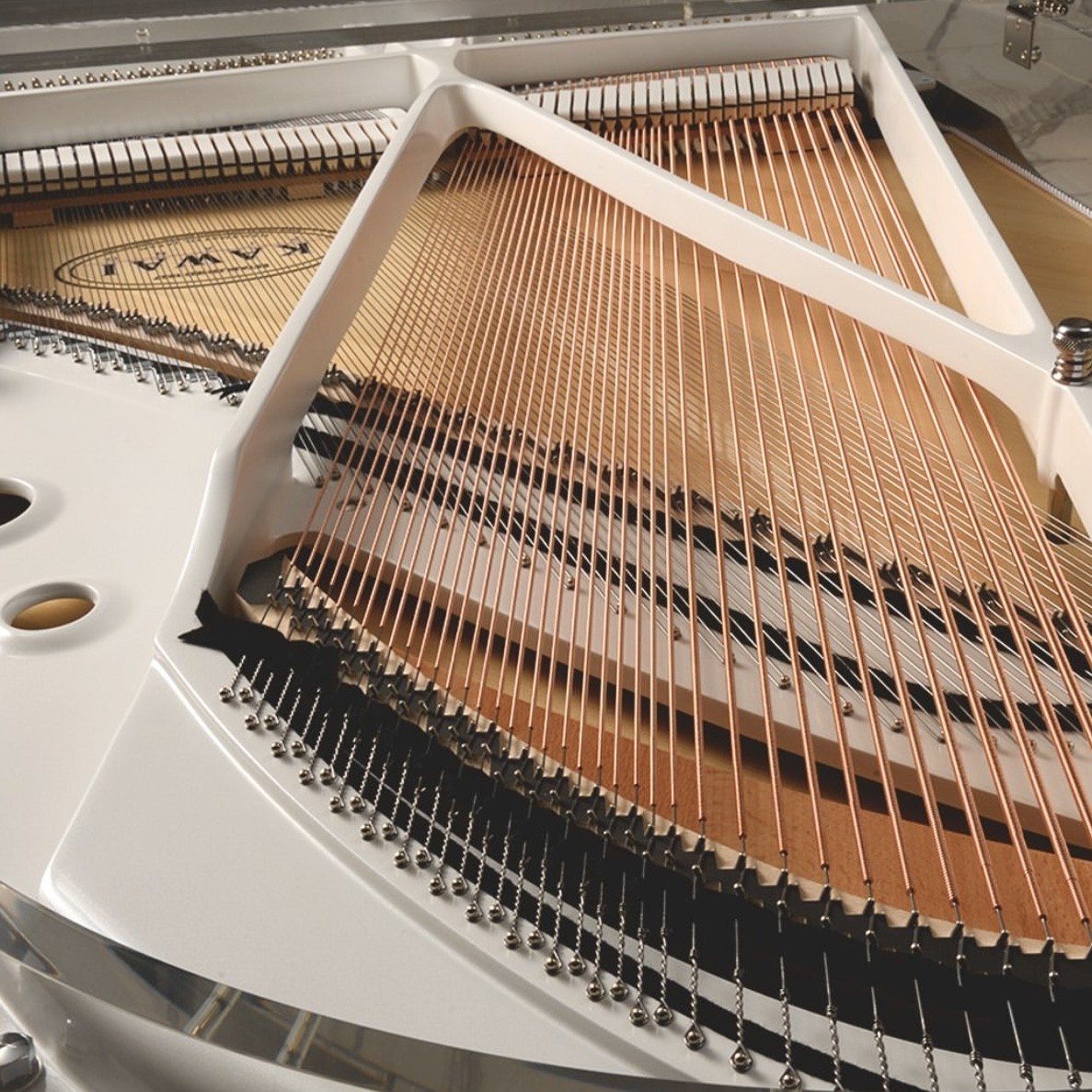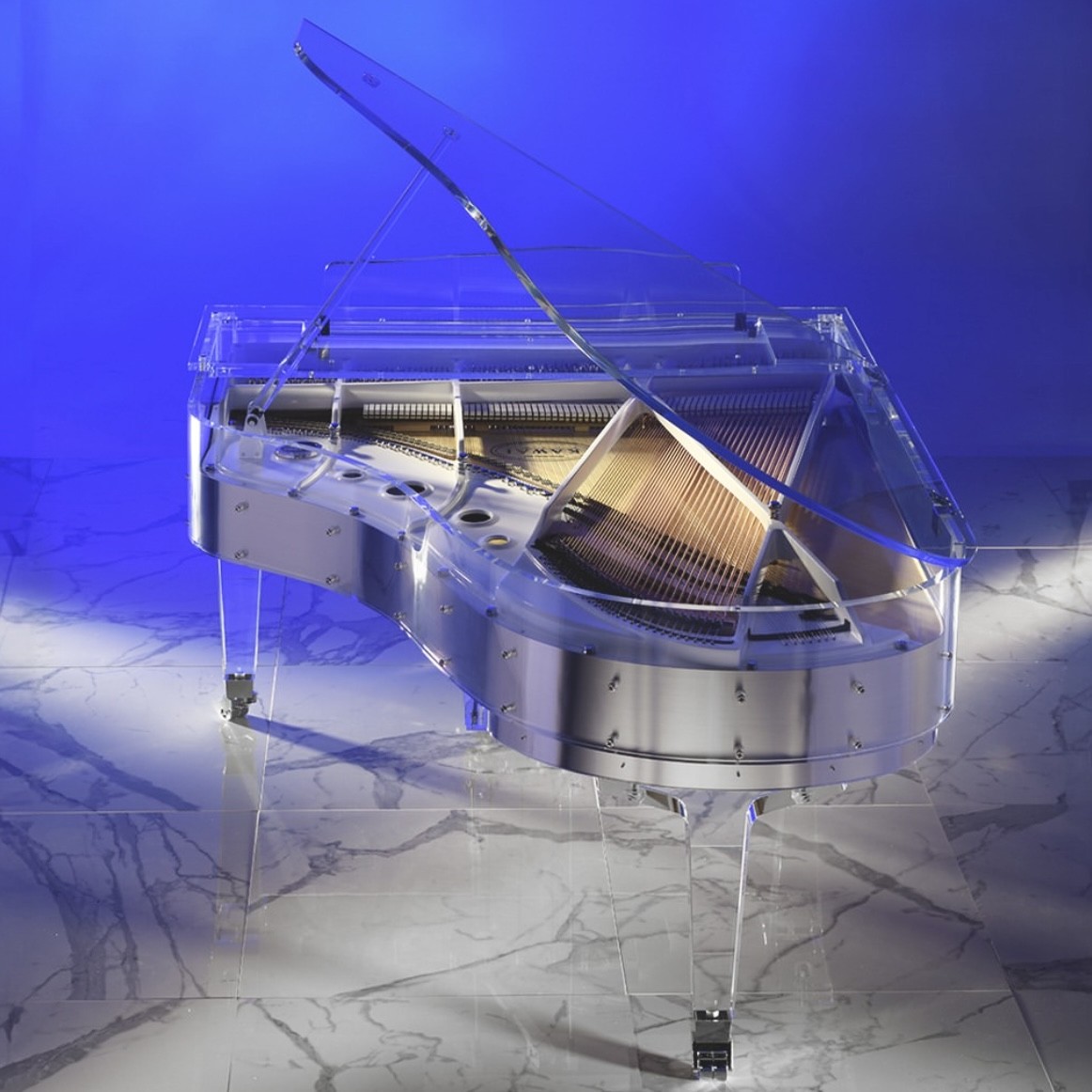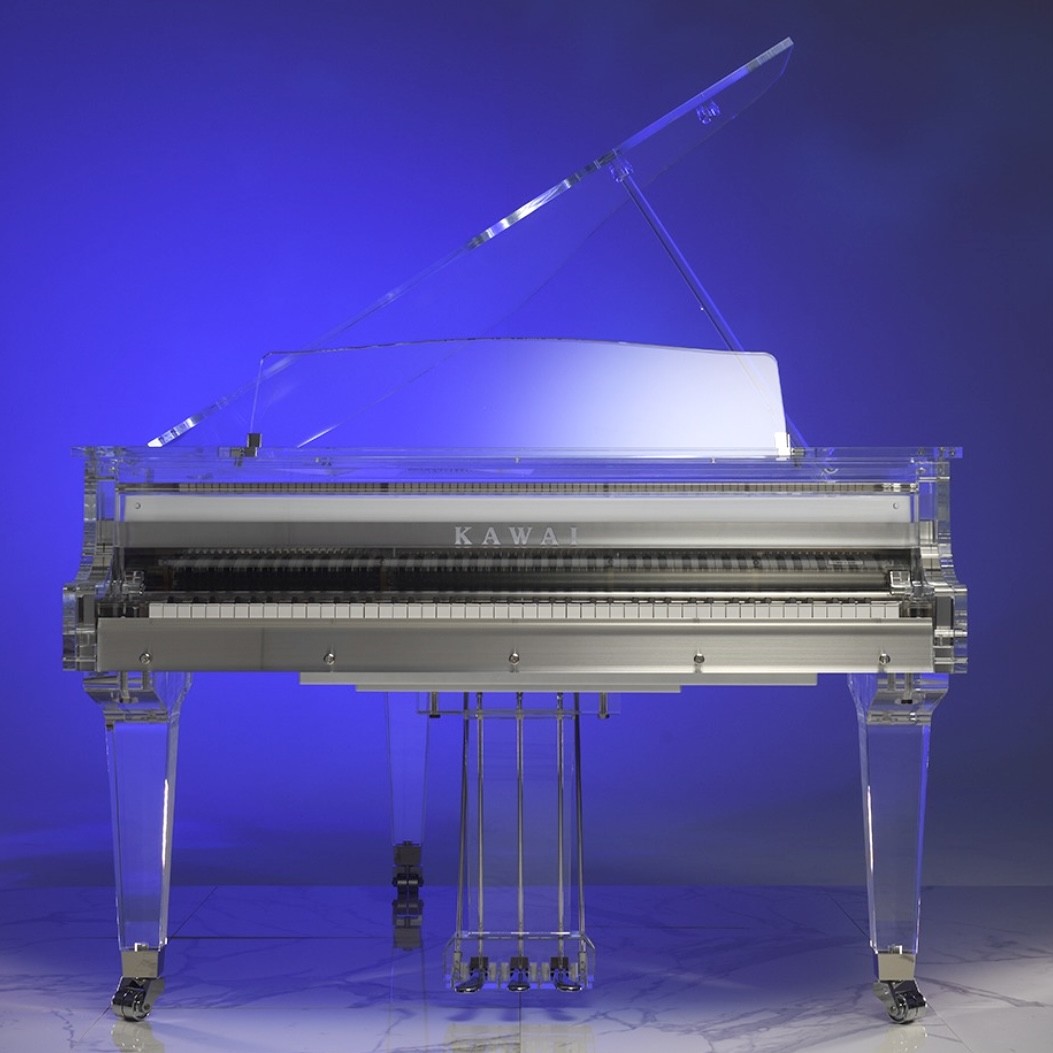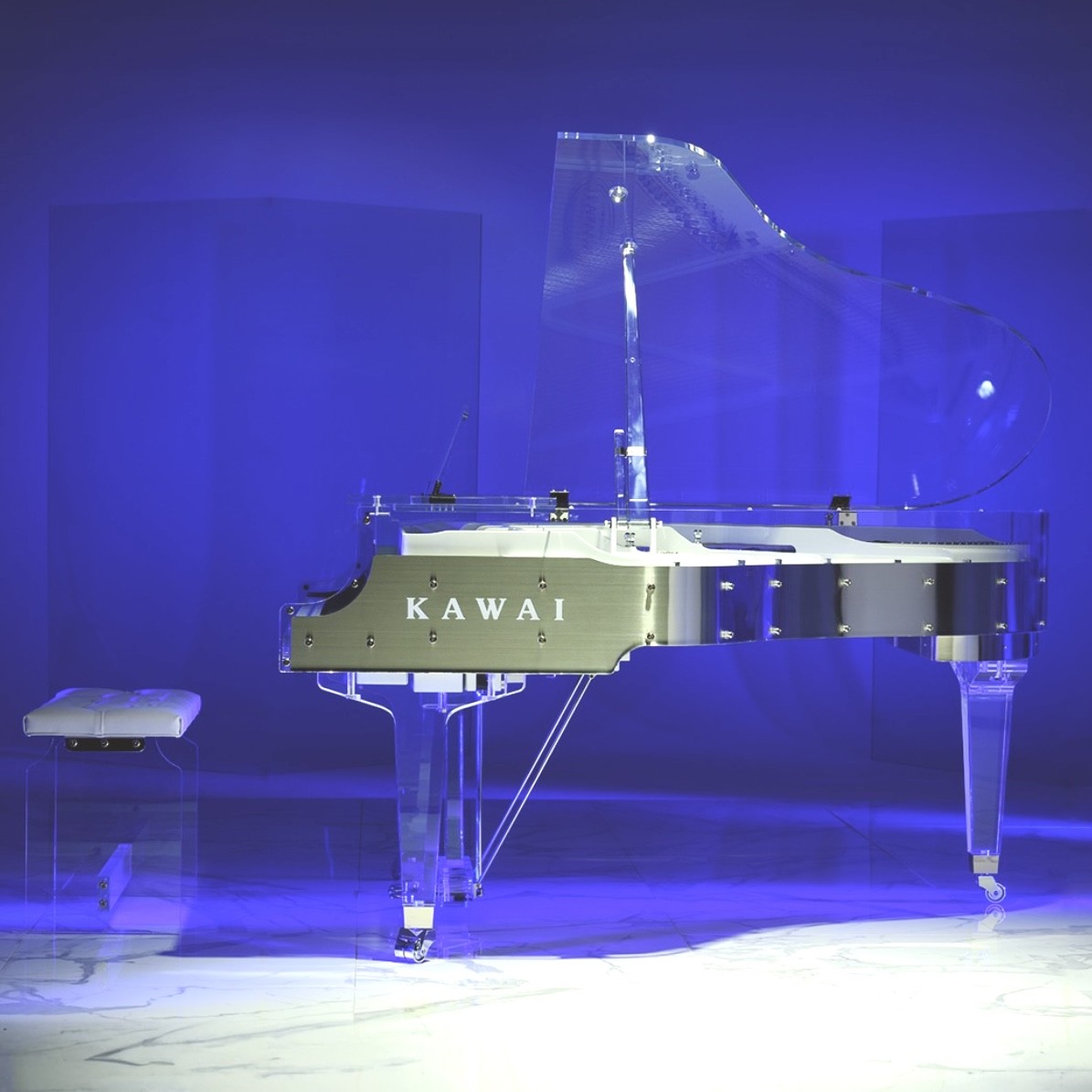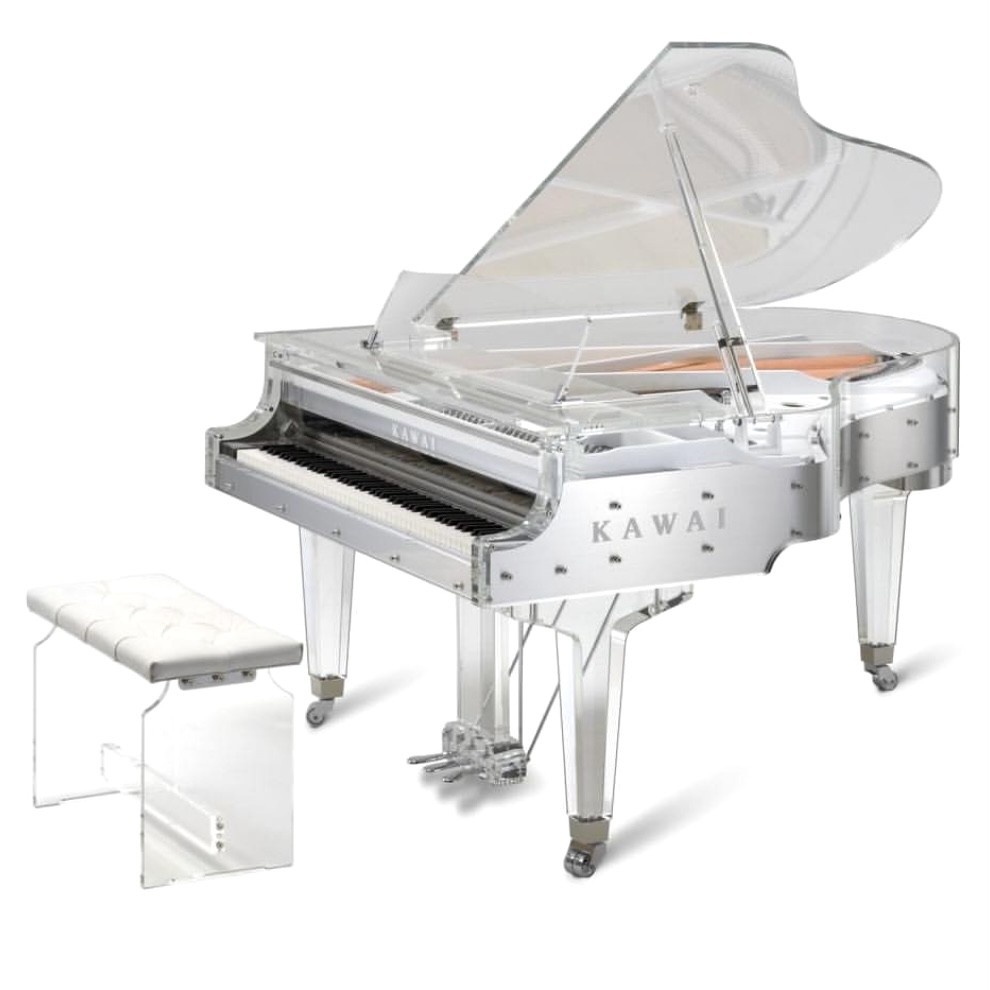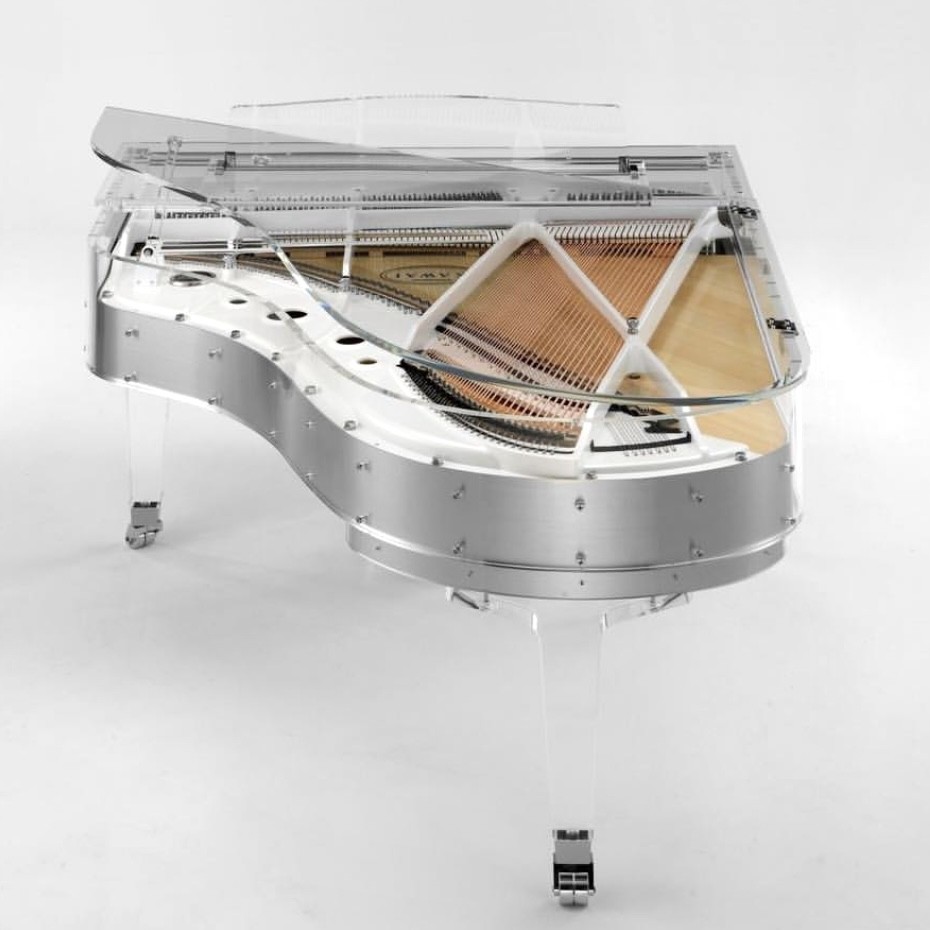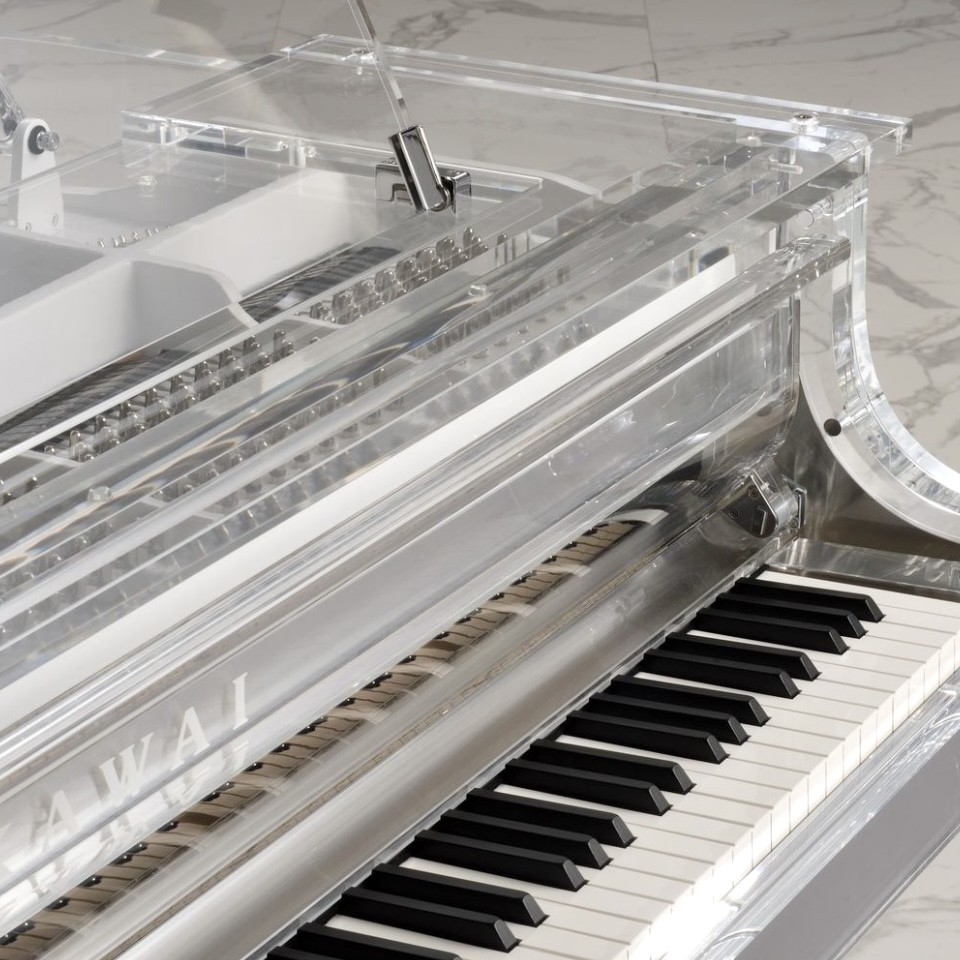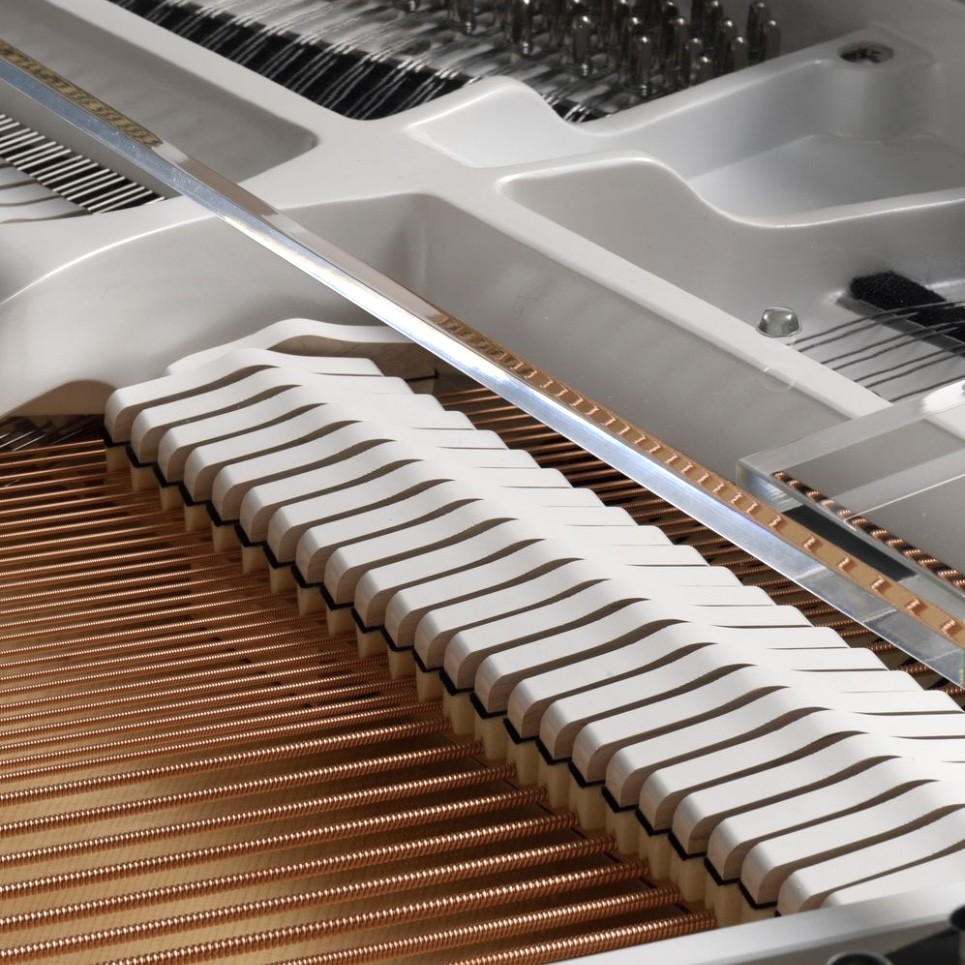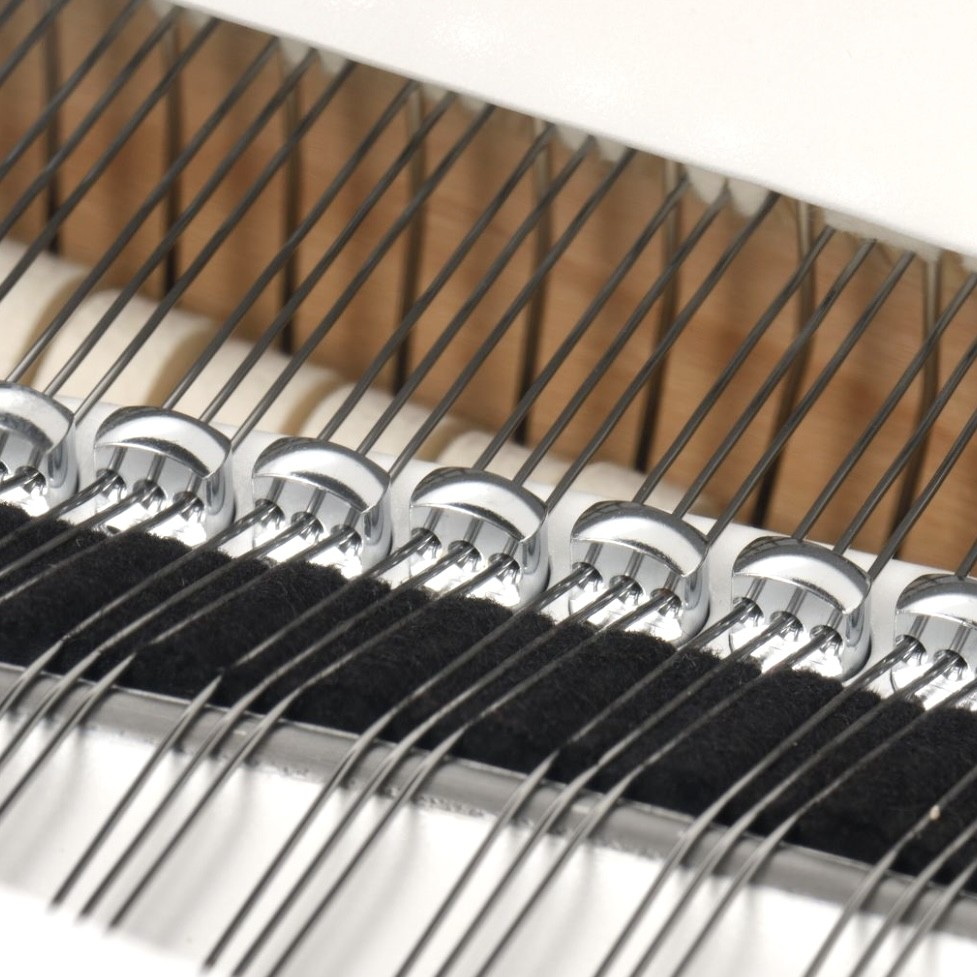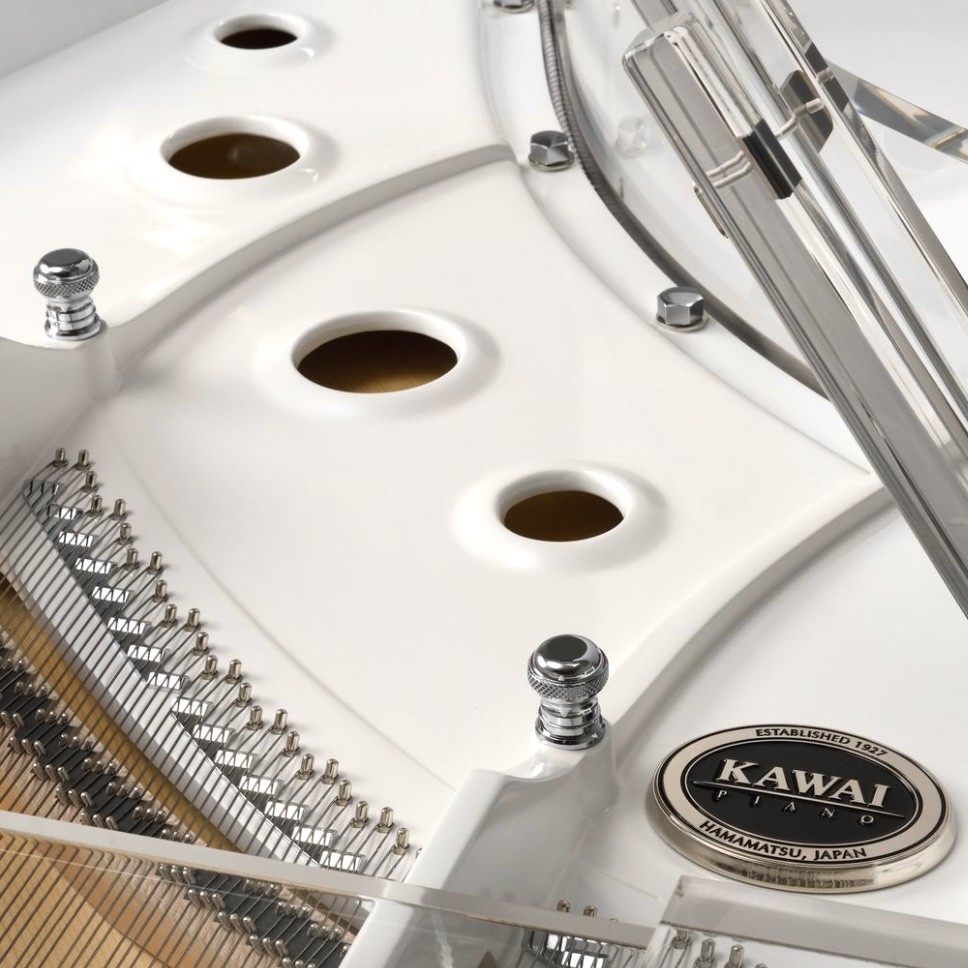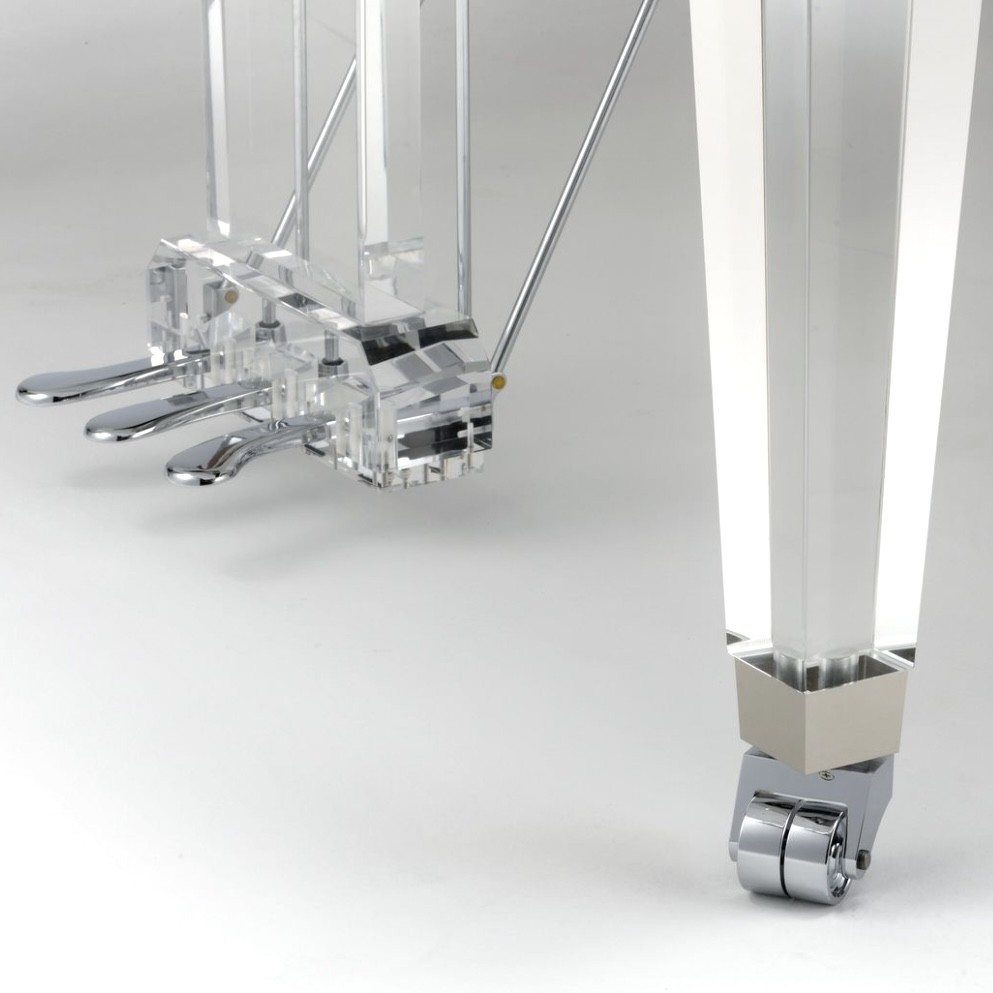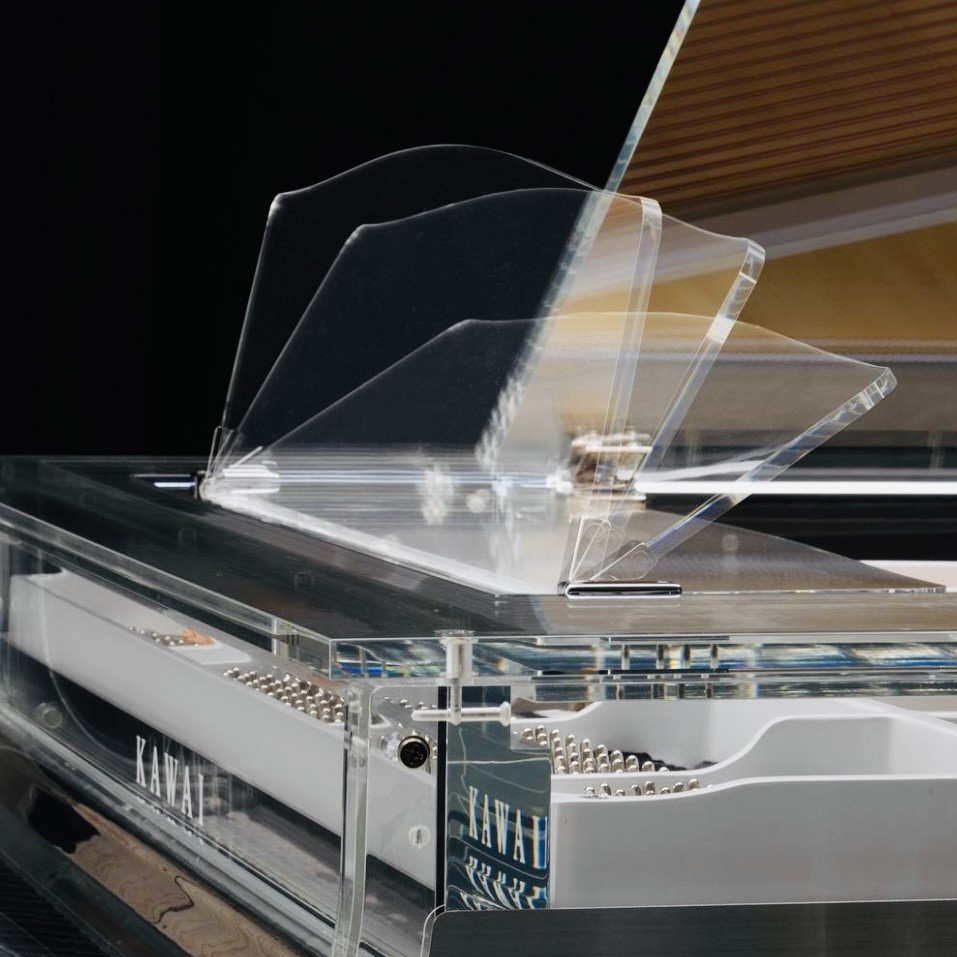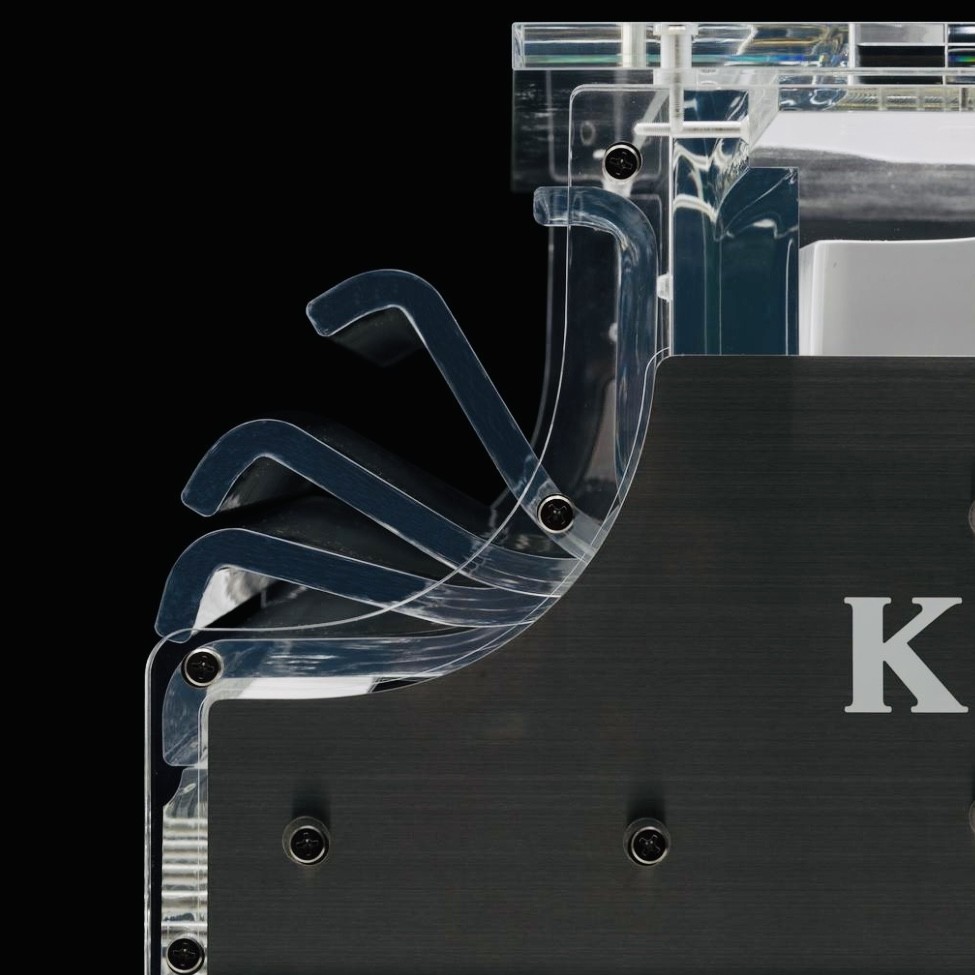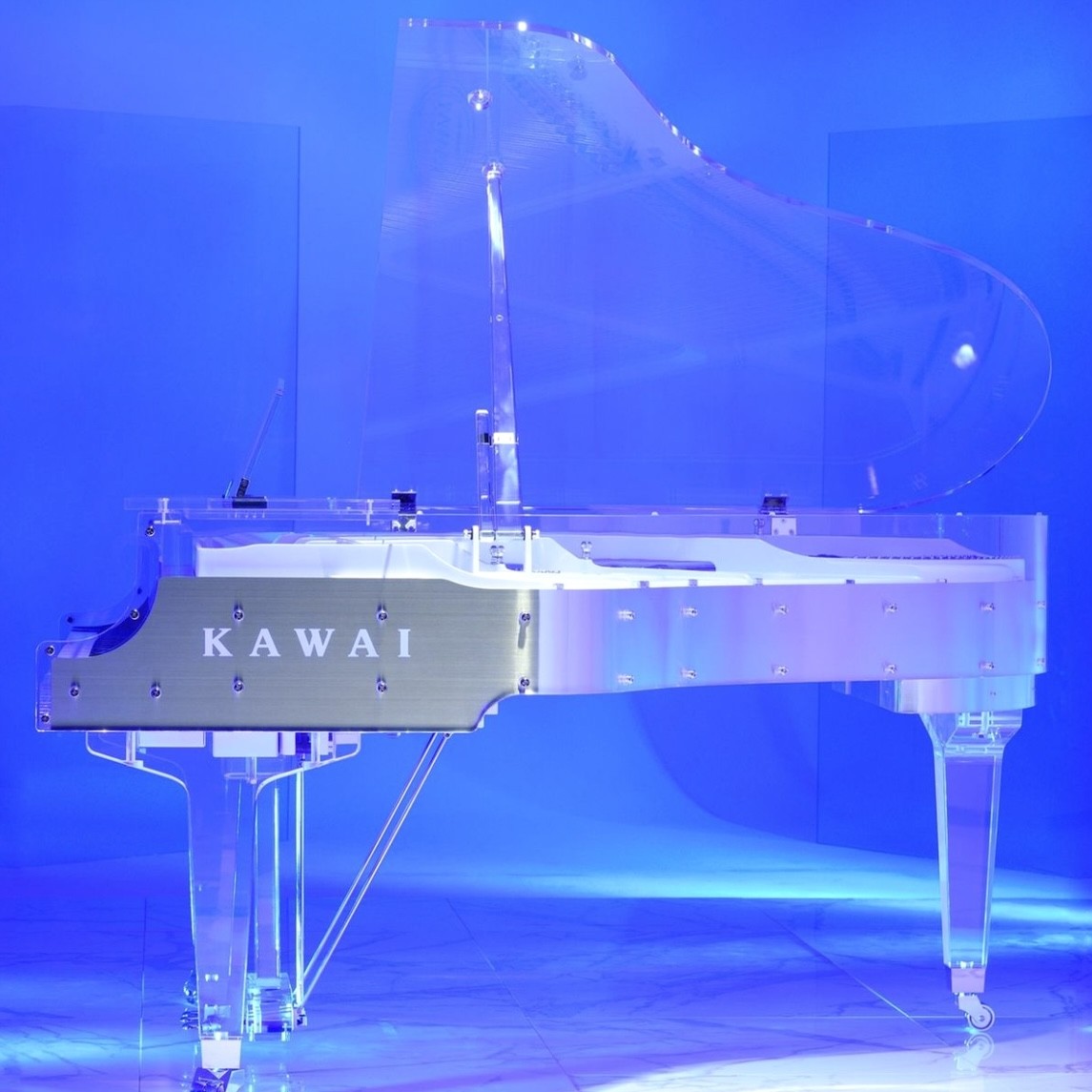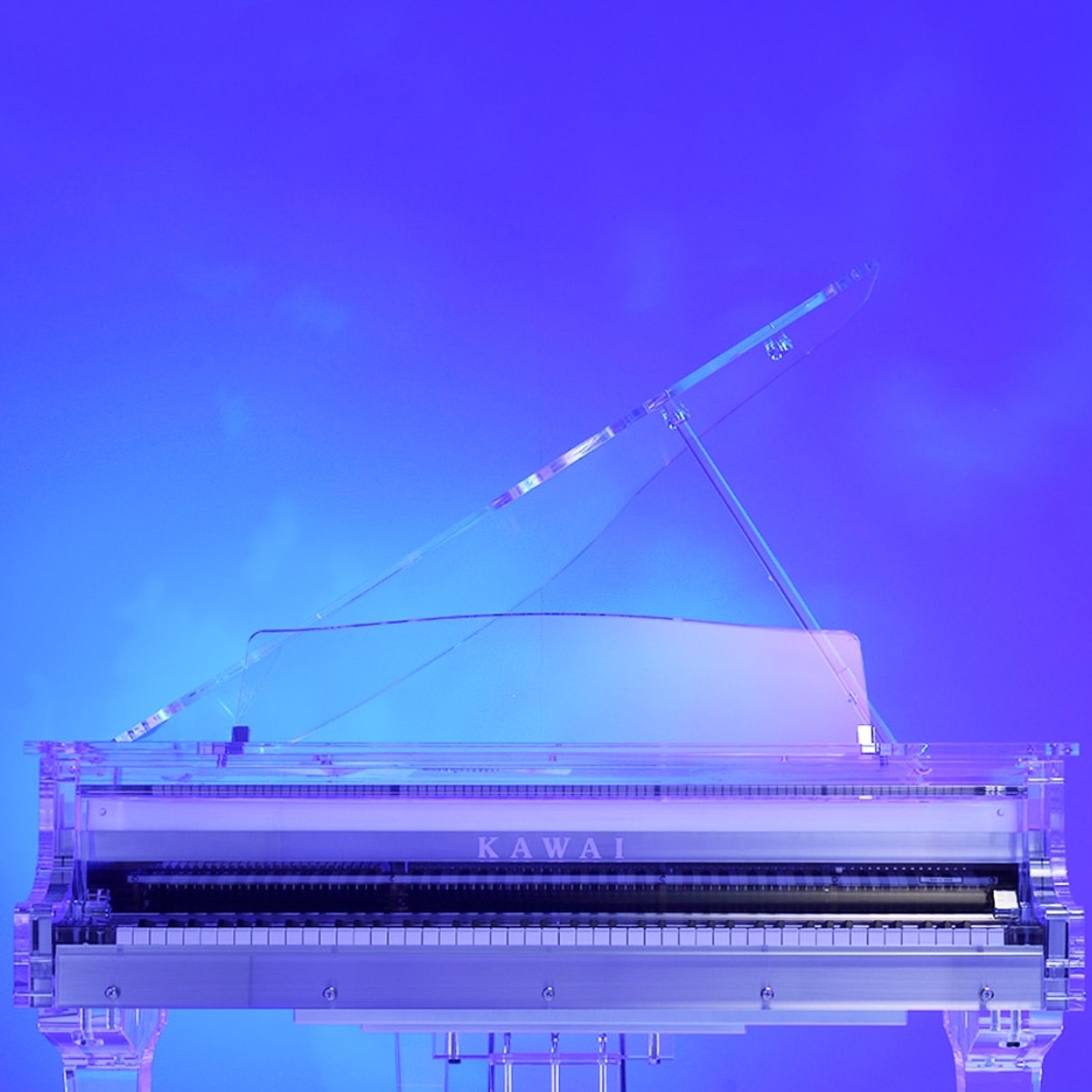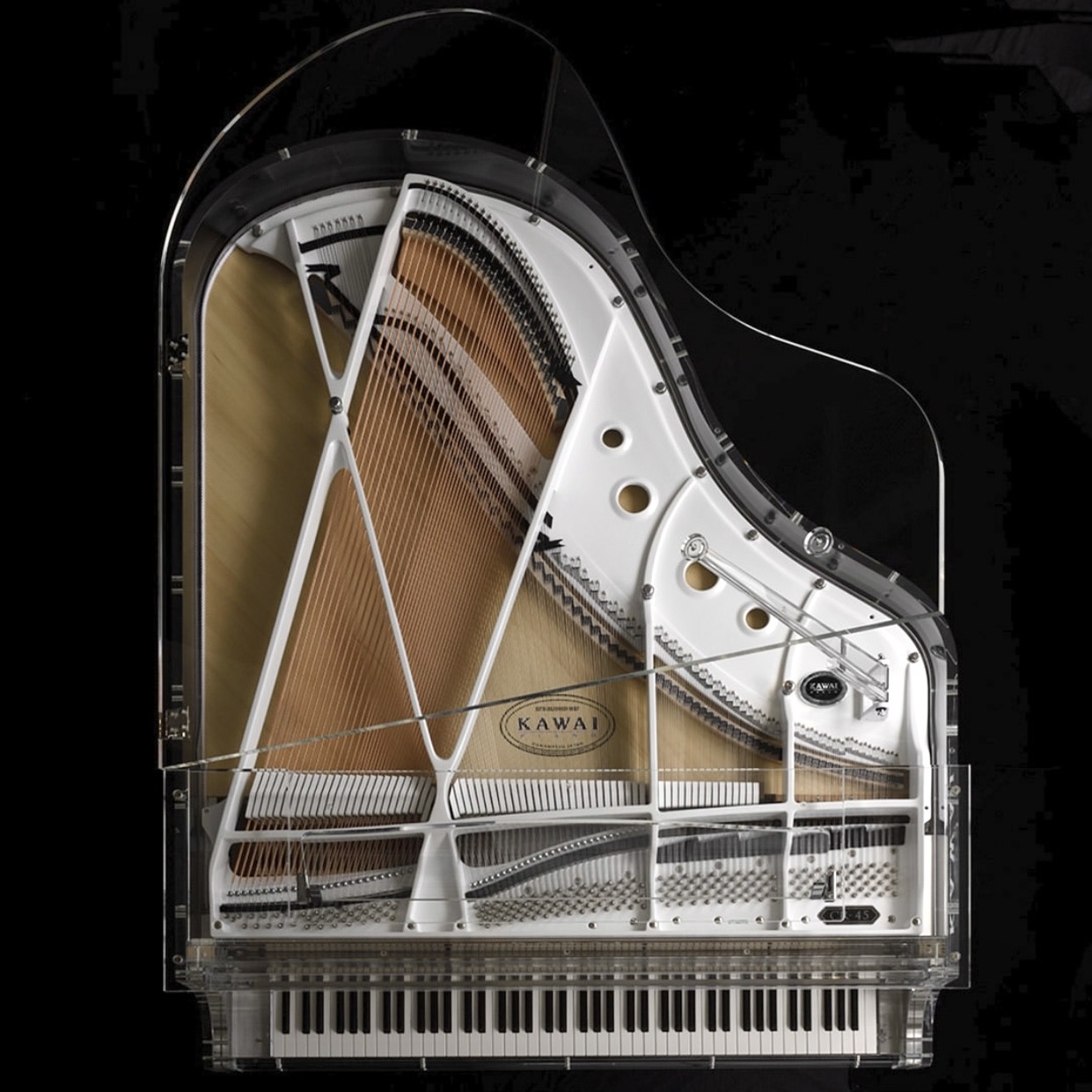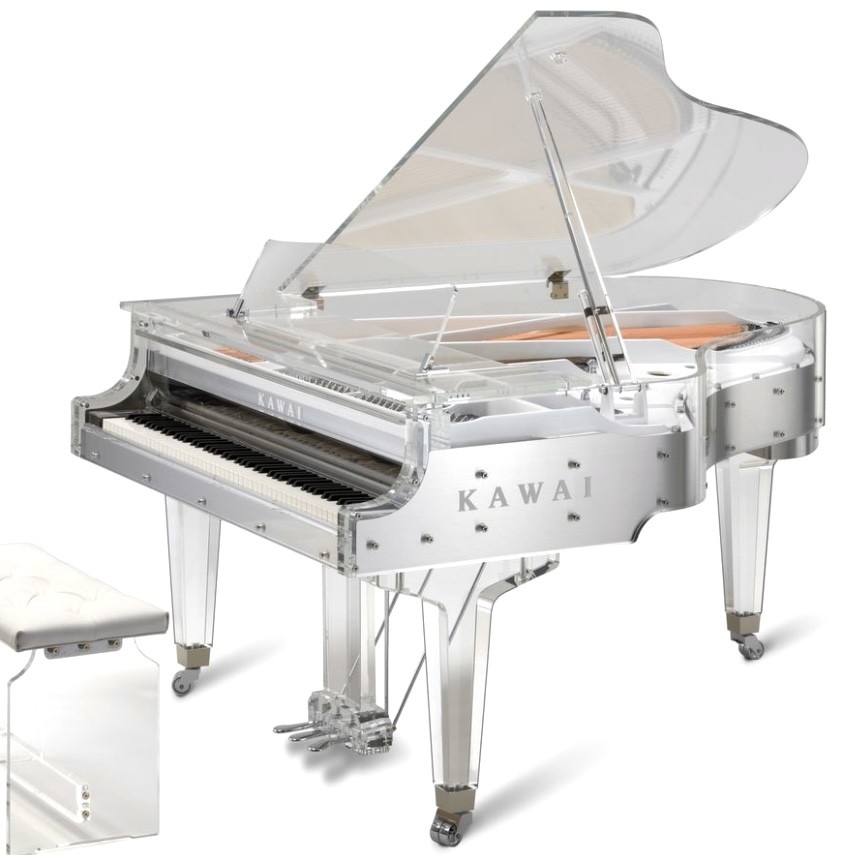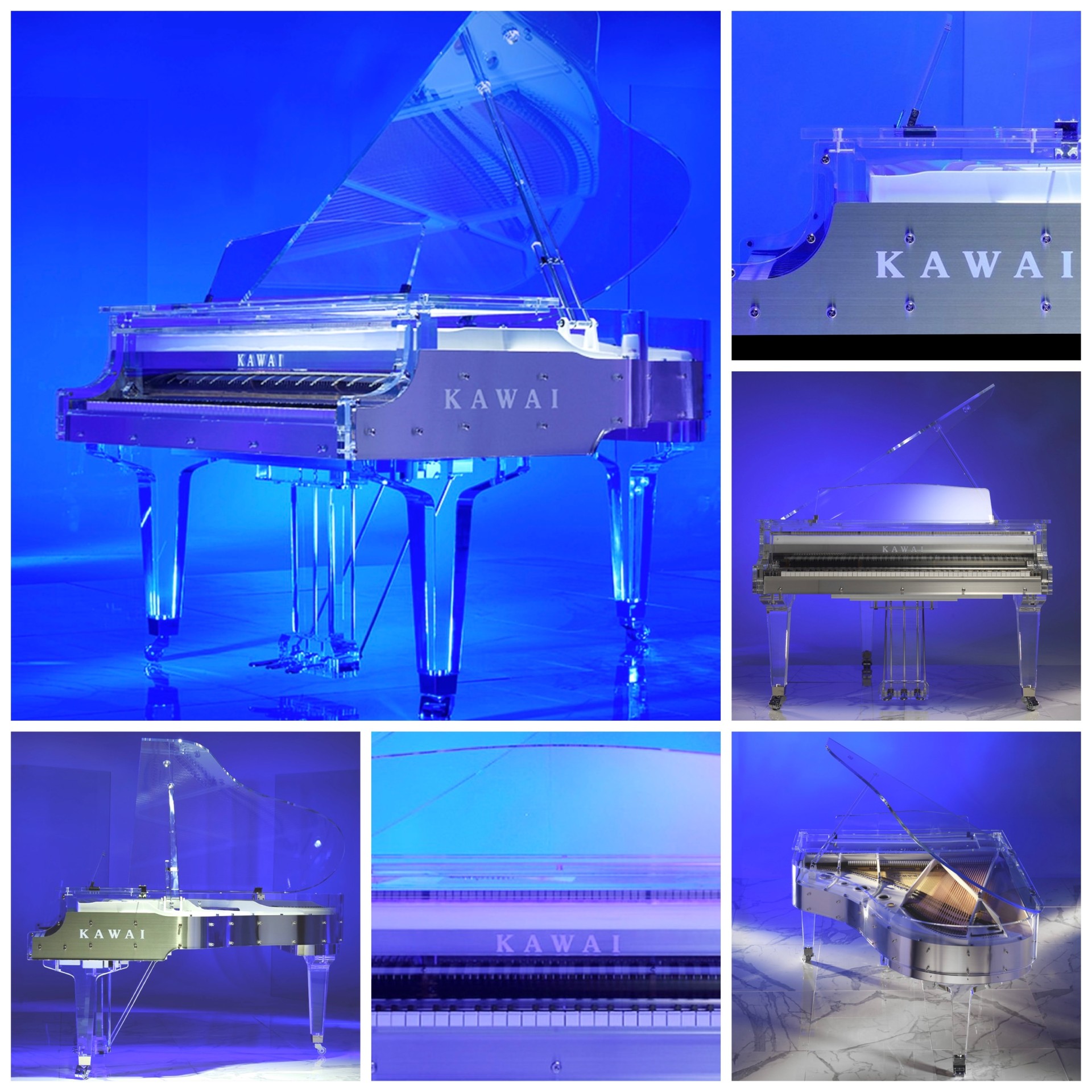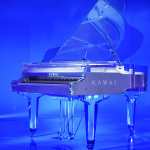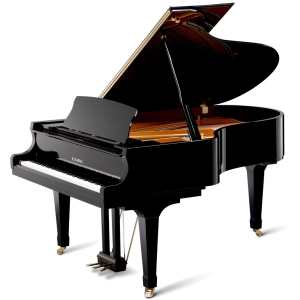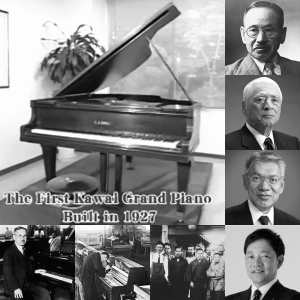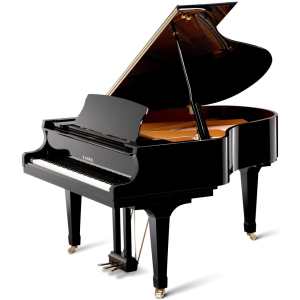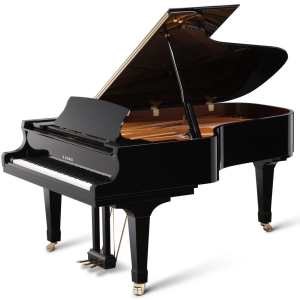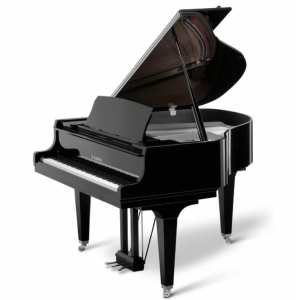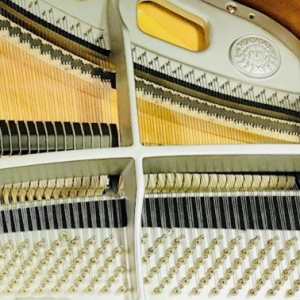Promenade Music is delighted to announce that Kawai Japan have released the new Kawai CR-45 which is the latest addition to Kawai’s renowned CR series of crystal grand pianos [successor to the CR-40A]. The CR-45 crystal grand piano is a handmade 185cm transparent grand that is handmade in Kawai’s award-winning Ryuyo piano factory in Shizuoka, Japan. Promenade Music is able to ‘special order’ a CR-45 for you and the typical lead-time from order to delivery is normally between six to nine months. A £50,000 deposit will be required when ordered and the balance will need to be paid for before delivery. Call Promenade Music on 01524 410202 or email [email protected] for more information.
Since Kawai’s introduction of their crystal grand pianos in 1971, they have attracted pianists and buyers with their beautiful appearance and high musicality, and as a piano being played by well-known musicians.
In pursuit of even greater beauty, this new crystal grand has been fully redeigned with new transparent parts which give a clearer and more vivid impression. Its unique entertainment value and overwhelming presence is ideal – not only as an excellent instrument – for a fantastic interior decor piece that creates a brilliant atmosphere in special spaces such as hotels, restaurants, luxury cruise ships, as well as the most beautiful modern designer home.
The new CR-45 has been redesigned to be a more beautiful, more luxurious and a higher specification than any previous Kawai crystal grand model. As well as its improved appearance, the new technical improvements for the player all give the impression of an enhanced pianistic experience from the smallest details like a longer key length (which improves playability), a new music stand (with stepless angle adjustment), the soft-fall fallboard over the piano keys (which closes slowly and naturally even if you accidentally release your hand when closing it) and double castors, all give the impression of enhanced stability and there’s no doubt that Kawai’s technical capabilities have met the demands of the player to create a high level of satisfaction and excitement when played.
Since 1927, Kawai has earned a reputation for outstanding quality, workmanship and innovation in the crafting of world-class instruments. Kawai acoustic and digital pianos are a top choice of pianists, teachers, students, and professional musicians around the globe. The skillful blending of traditional piano craftsmanship with state-of-the-art technology has made Kawai one of the most award-winning companies in the entire music products industry – having received over 50 major international awards for excellence – and their new CR-45 is going to prove a real winner for customers who want a great piano to play and a stunning piece of modern furniture.
More Information about Kawai Pianos.
The Kawai Family … Four Generations of Kawai Family Involved in Piano Making Since 1927
Kawai was founded in Hamamatsu [Japan] in August 1927 by Koichi Kawai (1886-1955) who had previously been an apprentice to Torakusu Yamaha (1851-1916). After Mr. Yamaha’s death, Koich left the team – who had taken over the control of Yamaha’s business – to build his own piano business. An extraordinary genius for design and innovation, Koichi had a never-ending quest for perfection which saw the foundations of great things for the Kawai company. After his sudden death in 1955, his son Shigeru Kawai (1922-2006) took over the company and advanced it into the realm of modern manufacturing. After Shigeru’s retirement in 1989, the company passed to his son, Hirotaka Kawai (1947-2024) who carried on the ‘commitment to excellence’, that was established by his father and grandfather, by incorporating advanced robotics into the production process. Following Hirotaka’s death in 2024, the presidency of the company passed to his son, Kentaro Kawai, the fourth generation Kawai to run what is now, one of the greatest and foremost award-winning piano makers in the world.
Kawai Players
Kawai have an honorable list of distinguished artists from every music genre and their testimonies of Kawai products. In the Players in The Classical Music World include: Mikhail Pletnev, Kenji Miura, Luke Jones, Mark Nixon, Can Çakmur, Ivan Ilić, David Quigley, Julian Saphir, Ashley Fripp, Anne Lovet, Lara Melda; and Players in The Popular Music World include: Chris Martin of Coldplay, Matthew Bellamy of MUSE, Neil Sedaka, Yoshiki, Neil Sutton of Human League, Ryan Tedder of OneRepublic, Rod Argent of The Zombies, Marty Grebb [Worked with: Willie Nelson, B.B. King, Olivia Newton-John], Don Airey [Worked with: Gary Moore, Ozzy Osbourne, Judas Priest, Black Sabbath, etc], Steve Nieve [Worked with: Sting, McCartney, Bowie, Bono, Springsteen], Trevor Horn [Worked with: Rod Stewart, Robbie Williams, John Legend, Seal] and David Witham [George Benson, Lee Ritenour, Brecker Brothers, Patti Austin] … to name but a few.
Institutions with Kawai Pianos
Promenade Music supplies educational institutions in the UK. There are many halls, conservatories and universities all over the world using Kawai pianos daily. It is impossible to name them all – as there are too many to name – but they include pianos in: England (Royal College of Music, Royal Academy of Music, Trinity Laban, Guildhall, Birmingham Conservatoire, Menuhin School, Purcell School); Ireland (Royal Irish Academy); Austria (Vienna Phil, Graz Opera, Wiener Symphony, Mozarteum Uni, Graz Uni, Anton Bruckner Uni, Vienna Conservatoire); Belgium (Royal Conservatoires of Brussels, Antwerp, Liège and Etterbeek); France (Paris Opera, Paris Conservatoire, Lyon Conservatoire, Bordeaux Conservatoire); Germany (Munich Conservatoire, Frankfurt Uni, Cologne Uni, Duisburg Opera, Hannover Uni, Hamburg Uni, Stuttgart Uni, Berlin Uni, Düsseldorf Opera, Freiburg Uni, Robert Schumann Uni, Folkwang Uni); Poland (Fryderyk Chopin Institute); Italy (La Scala Opera); The Netherlands (Amsterdam Conservatoire, Hague Conservatoire, Utrecht Uni, Prince Claus Conservatoire, Metropole Orchestra, Groningen Conservatoire, Hilversum Conservatoire); Russia (Russian National Orchestra, Tchaikovsky Conservatoire Moscow, Ufa Institute); Spain (Madrid Conservatoire, Sevilla Conservatoire, Granada Conservatoire, Málaga Conservatoire, Almería Conservatoire, Valencia Conservatoire); Switzerland (Zurich Uni, Geneve Conservatoire, Lugano Conservatoire, Swiss Jazz School, Buchs Conservatoire); Canada (Québec Conservatoire, Glenn Gould School Conservatoire, Alberta Uni, British Columbia Uni, British Columbia Uni, Toronto Uni, Vancouver Academy, etc); USA (The Juilliard School, Chapman Uni, Jacksonville Uni, Lincoln Center Arts, MIT Massachusetts, Saint Louis Opera Theatre, California Uni, Chicago Uni, Nevada Uni, Washington Uni, Wheaton College); China (National Centre for the Performing Arts, and the Conservatoires of Shanghai, Sichuan, Xian, Shenyang, and Tianjin); South Africa (Cape town Uni).
If you are a UK instiution looking at Kawai pianos, please call Promenade Music on 01524 410202 for more information.
All Wood Actions vs Kawai’s Millennium III Action Made of Wood & ABS-Carbon Components
Although wood is a wonderful material for the sound producing elements of a piano – like the soundboard, rim and hammers – it’s not great for some of the 8,000 parts in an action because it isn’t always as stable as we would like and can suffer from hummidity variations. The only material that piano inventors like Cristofori (who created the first piano action in the early 1700’s) and Erard (who created the double escapement action in the early 1800’s) had to work with in their day was wood; and I’m pretty sure if they were around today, they too would be using the most modern composites for the mechanical action parts as this is one of the parts of the piano that needs to be exacting and have unchanging precision, which wood can’t always guarantee because of its instability because of climatic changes. Kawai – like many leading companies in other industries – have moved towards the use of carbon-fibre to enhance performance of their products [think how carbon-fibre composities have made their way into improvements in tennis rackets, golf clubs, aircrafts, race cars, racing boats and performance cycles] and Kawai’s pianos have benefited from improvements to hammer strike (often flawed on pianos because of misaligned hammers due to the swelling and shrinkage in ‘all wood’ actions). Through composite action parts like ABS-carbon wippens, flanges and damper levers – which are impervious to hummidity change – Kawai hammers, strike the string with greater precision and the pianos maintain better touch and tone over long-periods of time. In our opinion, the Millennium III action is ‘best in class’ as its lighter weight and tremendous strength makes its playing speed, power and control the best action in its price point, and probably one of the main reasons why Kawai have one over 50 international awards for excellence. [David Wood, Promenade Music].
Call Promenade Music on 01524 410202 or email [email protected] for more information.

